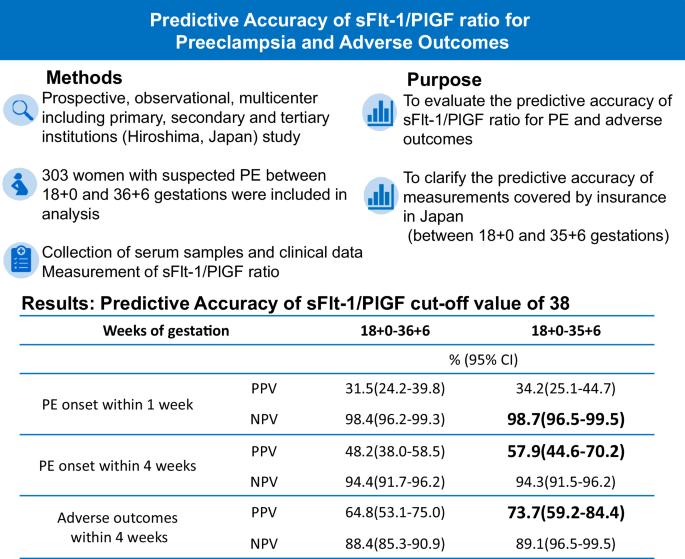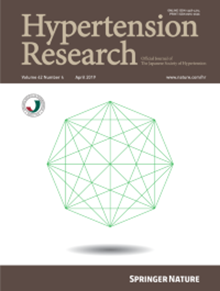sFlt-1/PlGF比率对子痫前期和不良结局的预测准确性:日本一、二、三级医疗机构的前瞻性、多中心观察性研究
IF 4.6
2区 医学
Q1 PERIPHERAL VASCULAR DISEASE
引用次数: 0
摘要
日本的产科护理分为3个级别,一半的分娩在没有新生儿重症监护室的初级设施进行。我们评估了sFlt-1/PlGF比值对日本多家医院(包括初级医院)疑似子痫前期孕妇发病和不良结局的预测准确性。356名怀孕18 + 0至36 + 6周的孕妇被纳入研究。303名女性参与了最终的分析。使用截断值38排除1周内子痫前期的阴性预测值为98.4% (95% CI, 96.2-99.3),阴性似然比为0.22 (95% CI, 0.09-0.53)。使用截断值38,4周内判定子痫前期阳性预测值为48.2% (95% CI, 38.0-58.5)。使用截断值85的阳性预测值为65.0% (95% CI, 44.1-81.4),阳性似然比为12.21 (95% CI, 5.20-28.80)。使用截断值38预测4周内不良结局的阳性预测值为64.8% (95% CI, 53.1-75.0)。为了明确目前在日本保险范围内的检测的准确性,我们还对18 + 0至35 + 6周的孕妇进行了分析,得出了更高的准确性。sFlt-1/PlGF比值为bb38的孕妇应转诊到更高一级的医疗机构。在初级和三级保健机构的大力合作下,适当使用sFlt-1/PlGF可能有助于改善日本的围产期结局。本文章由计算机程序翻译,如有差异,请以英文原文为准。

Predictive accuracy of sFlt-1/PlGF ratio for preeclampsia and adverse outcomes: prospective, multicenter including primary, secondary, and tertiary care institutions, observational study in Japan
Obstetric care in Japan is organized in 3 levels and half of all deliveries are conducted at primary facilities without neonatal intensive care unit. We evaluated the predictive accuracy of the sFlt-1/PlGF ratio for the onset of preeclampsia and adverse outcomes in pregnant women with suspected preeclampsia at multiple facilities in Japan, including primary facilities. 356 pregnant women from 18 + 0 to 36 + 6 weeks of pregnancy were enrolled. 303 women were included in the final analysis. The negative predictive value for ruling out preeclampsia within 1 week using the cut-off value 38 was 98.4% (95% CI, 96.2–99.3) with a negative likelihood ratio of 0.22 (95% CI, 0.09–0.53). The positive predictive value for ruling in preeclampsia within 4 weeks using the cut-off value 38 was 48.2% (95% CI, 38.0–58.5). The positive predictive value using a cut-off value of 85 was 65.0% (95% CI, 44.1–81.4) with a positive likelihood ratio of 12.21 (95% CI, 5.20–28.80). The positive predictive value for prediction of adverse outcomes within 4 weeks using the cut-off value 38 was 64.8% (95% CI, 53.1–75.0). To clarify the accuracy of the test currently covered by insurance in Japan, we additionally conducted an analysis focusing on pregnant women between 18 + 0 and 35 + 6 weeks, yielding even higher accuracy. Pregnant women with sFlt-1/PlGF ratio >38 should be referred to a higher-level medical institution. The appropriate use of sFlt-1/PlGF supported by a robust collaboration between primary and tertiary care institutions may help to improve perinatal outcomes in Japan.
求助全文
通过发布文献求助,成功后即可免费获取论文全文。
去求助
来源期刊

Hypertension Research
医学-外周血管病
CiteScore
7.40
自引率
16.70%
发文量
249
审稿时长
3-8 weeks
期刊介绍:
Hypertension Research is the official publication of the Japanese Society of Hypertension. The journal publishes papers reporting original clinical and experimental research that contribute to the advancement of knowledge in the field of hypertension and related cardiovascular diseases. The journal publishes Review Articles, Articles, Correspondence and Comments.
 求助内容:
求助内容: 应助结果提醒方式:
应助结果提醒方式:


